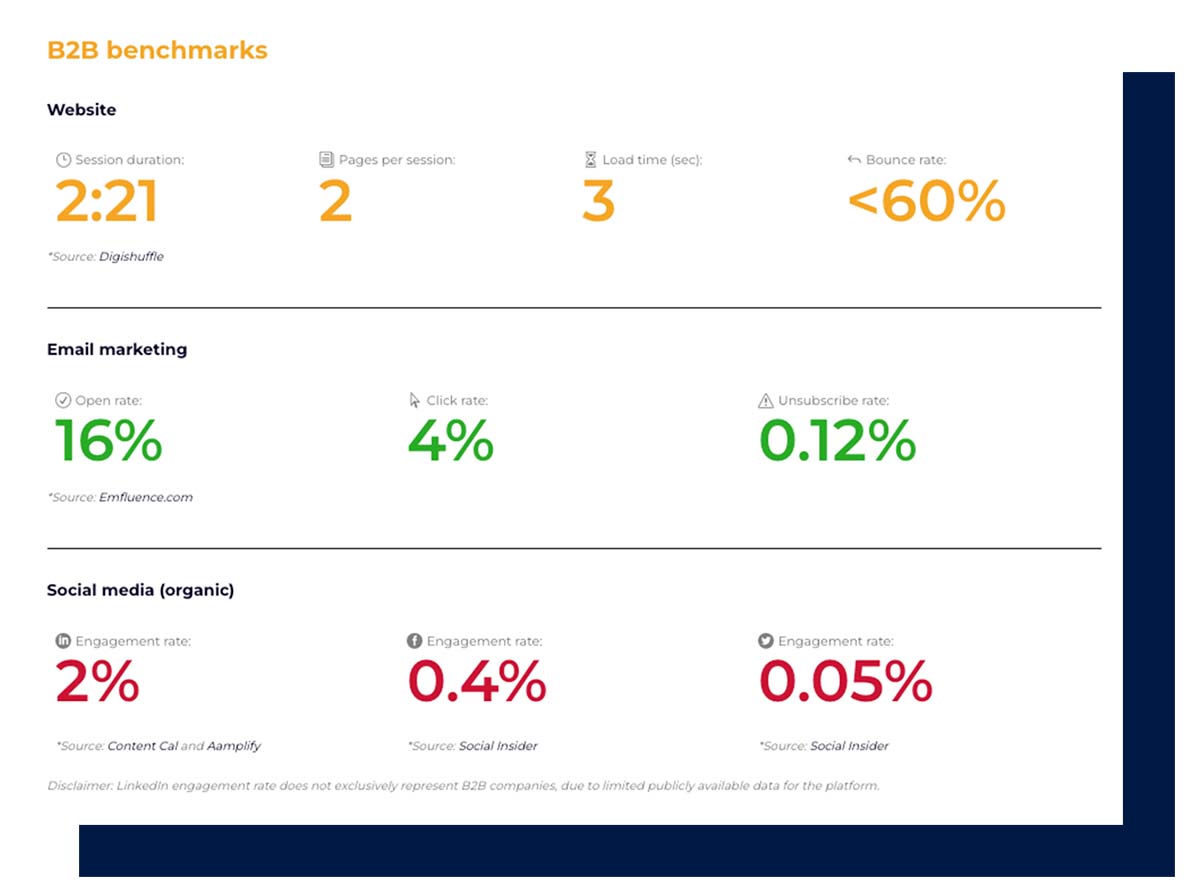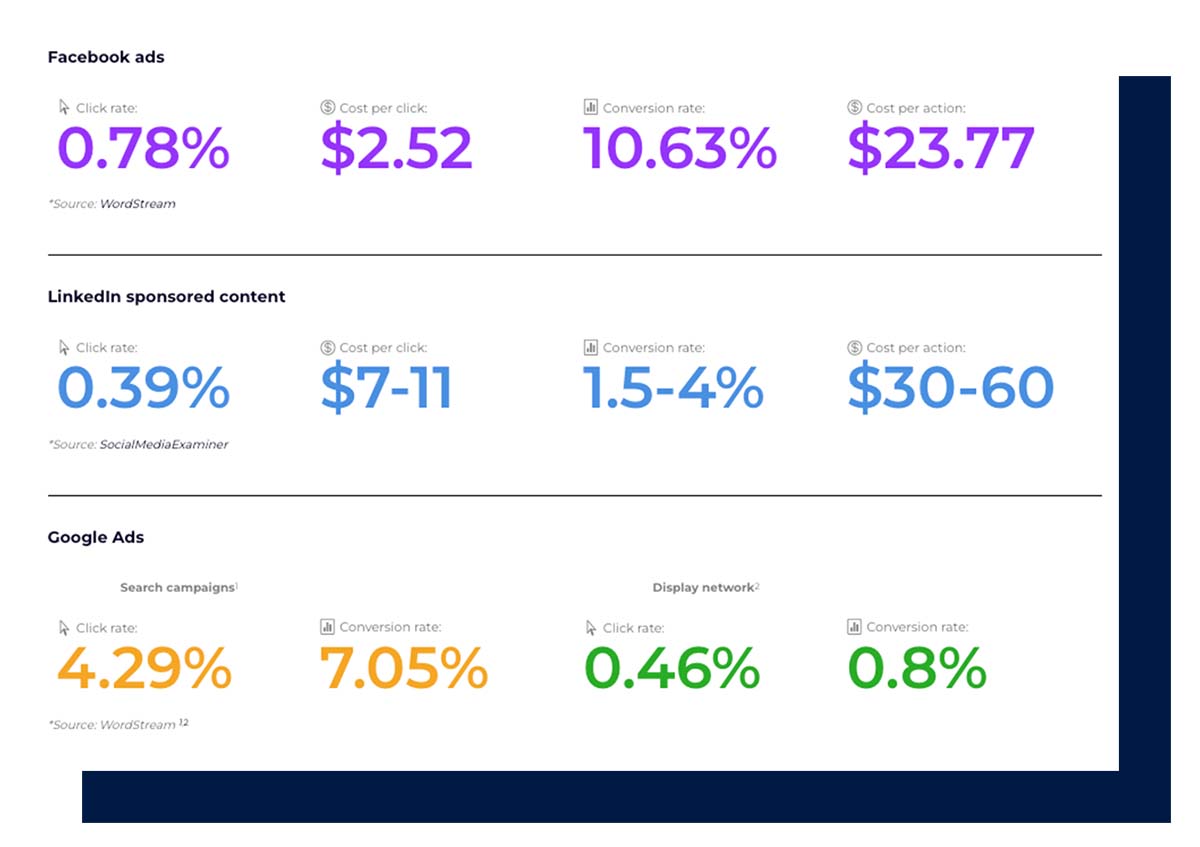Give yourself a break! That’s right. You there, pouring over your inbound marketing metrics, desperately trying to figure out why your strategy and tactics aren't delivering in the way you hoped.
Don’t be so hard on yourself! Inbound marketing is tough. Even brands with zillion-dollar budgets struggle. Setting goals, creating and delivering high-performing campaigns, measuring engagement, managing the expectations of senior management — it’s not for the fainthearted.
Let’s get real and look at how you can set realistic expectations for your inbound marketing activities. Get to grips with what your current content production capacity is and where you should direct your efforts. Identify the KPIs that matter and the benchmarks that will shape and optimize your inbound marketing strategy.
Let’s get started.
What do you want to achieve from inbound marketing?
Gather your team and work out what you want to achieve from your inbound marketing activities. Why are you doing what you’re doing? Is it enough to attract these lovely warm, toasty leads you need to stay ahead of the game — or to keep your current customers coming back for more?
Every inbound marketing campaign should be 100% aligned with your business goals and objectives. Your time and budget are far too precious to whittle the hours away producing content that simply doesn’t resonate with your potential customers.
This is the time to consider the wider picture. So why not lure your sales and/or customer service team over with the promise of freshly brewed coffee or cold beer if the time of day allows, and get busy answering the following questions:
- Who are you currently attracting and how can you reach the leads who are eluding you?
- Are your buyer personas and ideal customers really who you think they are?
- Are they using the marketing channels you expected? If not, wherein heaven’s name are they?
- Which content are people responding to, and at what stages of the buyer journey?
- Where are the content gaps? What additional content does your sales team need to convert those leads?
- Do you currently have the production capacity for this? If not, are there content marketing materials that you can repurpose or update? Or perhaps you need to think about extra hands on deck.
- How are you measuring your inbound marketing activities in the short- and long term? Perhaps there are metrics that could serve you better.
Use our template of questions to help you determine what you want to achieve from your inbound marketing efforts.
What's your current content production capacity?
In order to set realistic inbound marketing expectations and create an effective inbound strategy, you need to have a good understanding of your content production capacity.
Start by conducting an audit of all the fabulous content you have produced in the last year or so. Break it down by content format, the time taken to get it from ideation to publication, the budget needed to produce each piece or each campaign, ROI, external support required, etc.
Even those of us who love nothing more than a pivoted table or fancy-filtered spreadsheet can find this a time-consuming exercise so why not use a tool to do the legwork.
At Foleon, we use the monday.com project management tool to track our processes. This helps us understand what’s taking more or less time and how much content we’re actually producing. Ultimately it gives us the information we need to understand where we can optimize processes to produce more content assets efficiently.
Once you have your current content mapped out, it’s time to start spring cleaning. This is a valuable opportunity for identifying those high-performing assets that can be repurposed for different audiences and channels. It is also the ideal point to ditch those assets that have had their day.

How much inbound marketing content do you need to produce?
The overall picture should be starting to come into focus now. Looking at your capacity and your KPIs, start to work out what you might be able to realistically achieve.
We all know that quality is way more important than quantity. But in order to be successful in your inbound marketing activities, you will need to produce enough content to reach your audience(s) at each stage of the buyer journey. You’ll need to publish relevant, topical content that shows you have your finger on the pulse and keeps you at the forefront of people’s minds.
A 2022 report from Hubspot revealed nearly half (47%) of buyers view three to five pieces of content before reaching out to a sales rep with a fair chunk of this content likely to be blog posts.
Super-shareable, fabulous for SEO, entertaining and informative, blogs are one of the most valuable links in your customer journey. So how many do you need to create? Time to refer to your inbound marketing goals once more.
If you are all about boosting your organic traffic, aim for three to four new posts a week (these can be quite short, say 500 words, if resources are tight) and four to five posts a week of repurposed or longer content. This should keep Google et al happy and allow enough time for each blog to gain traction.
For increasing brand awareness the frequency can be dialed back a few notches. Aim for one or two shorter blogs each week and three to four longer or repurposed articles.
Of course, you do need your production quota to be manageable and sustainable in the long term. If five articles with sufficient promotion aren’t doable, then cut it down to three or whatever is possible.
When your production quotas are sustainable in both the short and long term you can feel confident in committing to the optimization activities that will truly amplify your content and get it in front of the right people. Consistency is often more important than frequency when it comes to social media, e-newsletters, and other forms of content promotion.
Similarly, if you are desperate to create more video content, as you just know it’s gonna resonate big-time with your leads, you’ll need to consider the additional time and financial resources this could entail and make sure it is manageable.
But, here’s an idea. If your sales team is open to the idea of working more with the Marketing Department, get that coffee pot on and see if anyone is up for some video content creation. Why not get your customer service or product development team in on the action, too?
Many businesses have TikTok enthusiasts in their ranks who may jump at the chance of producing some valuable video content. Alongside getting some great new ideas and voices onboard, it’s also a great activity for bringing team members together and learning from one another.
How do you measure inbound marketing?
So, here’s the biggie. How do you know your inbound content marketing strategy is working?
Ask any marketer this question and they are likely to tell you stories of expensive analytics packages that didn’t deliver, ongoing nightmares with last-click attribution, and generally journeying from Wit’s End and back again on a pretty regular basis.
But don’t despair. It can be done. And do it, we must.
There are a number of ways to determine whether inbound marketing is effective and that all depends on your business goals. These include:
- Organic website traffic and engagement (e.g time on page, scroll depth, links clicked).
- Marketing Qualified Leads (MQLs), Sales Qualified Leads (SQLs), offers that have been accepted by sales, and deals from organic sources.
- Conversion rates (downloads, links clicked, newsletter signups, contact forms, calls to the sales team, and so forth).
- SEO rankings.
- Bounce rates (remembering to take into account why a visitor seems to be leaving the page — if they left to go to a contact form it’s a happy bounce!).
The important thing is to get to grips with what each KPI is actually saying about your audience’s engagement and intentions. You can then use those metrics to optimize your strategy, prioritize your activities and determine whether your goals are realistic or not.
You’ll also need to take into account the content formats that you can’t measure well (yet). Take PDF downloads for example. Producing PDF brochures, e-books, reports and other content marketing resources generally takes a significant amount of time and effort. But understanding how successful they are is a challenge.
Sure, you can see downloads, but you can’t see time on page, clicks, interactions, etc. Switching to a different format could be a great way to not only get more insights but also to produce this content faster.
Discover the best PDF alternatives and how to get started.
Benchmarking your inbound marketing
There’s a two-pronged approach to benchmarking your inbound marketing activities:
- Setting your long-term goals based on industry benchmarks.
- Creating milestones based on your own past performance.
Industry benchmarks come with a big ol’ caveat. Company size, the sector you operate in, your budget, audience, and all sorts of factors will affect how well your business can reasonably be expected to perform.
Plus if you are starting with very little you shouldn’t expect to hit industry benchmarks in a quarter, or even a year. Inbound marketing is a long-term strategy, after all!
Here are some industry benchmarks to set your sights on:
When it comes to benchmarking your performance based on past campaign successes, the right metrics and gauges to use will depend on your goals and objectives. Whatever you decide to measure, start by establishing a timeline to help you chart your progress.
So, if you want to increase your conversions by 30% YOY you can map your activities against the timeline to monitor what is and isn’t working and adjust your strategy accordingly.

(Source: Koroberi)

(Source: Koroberi)
How do I communicate inbound goals and progress with senior leadership?
Most everyone in content marketing is bound to have some not-so-fond memories of compiling fabulous reports detailing all the wondrous inbound marketing activities our department was up to and what we had achieved. Then most of it fell on deaf ears.
It’s usually not because our efforts or accomplishment aren’t valued. But rather because we’re not providing them with the information they really want to see.
The best way to communicate inbound goals and progress with senior leadership is to show a few key stakeholders the metrics on offer and ask them what info they need.
Explain what each activity and each metric are, why they matter, and how they all fit together. Armed with their feedback you can then structure a badass report.
Always lead with the killer metrics, the concrete results that they can digest at a glance. It could be worth explaining how you got them, especially if it involved a new tool you had to beg your finance department for. But don’t go into too much detail. Far better to focus on the results.
Always frame your report around the business’s strategic and operational goals. For example, if the company strategy is to make an impact in new European markets then get that data front and center.
Always include information on progress over time and always, always avoid vanity metrics. They’ll see through this straight away and it will distract from your achievements and damage your credibility.
Discover: What to Know About Developing Content for Your B2B Inbound Strategy
The power of playing the long game
We’ve mentioned before that inbound marketing is a long-term strategy. Therefore, as with just about everything on your marketing plan, you’ll need to revisit your strategy and goals over time. The market will change. Your customer’s needs will evolve. The tools and tech you can use to ease your journey will become more and more sophisticated.
Don’t lose sight of the value and benefits of your inbound marketing activities. While it takes time to deliver valuable, relevant, interesting, and entertaining content to your customers, it is also one of the most effective ways of growing your business.
There are many great content marketing activities for attracting leads and building loyalty. It’s about finding the ones that suit your business model and that will delight your audience.
Keep creating. Keep listening. Keep testing. Keep analyzing. You’ll get there sooner than you think, and the rewards will be 100% worth it.
Discover: How to Make a Case for Building an Inbound Marketing Program



